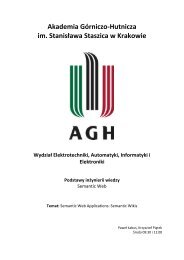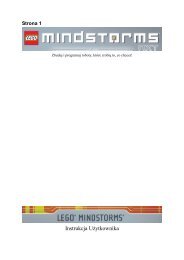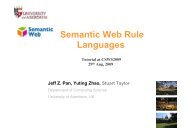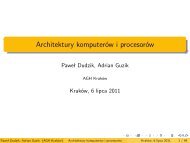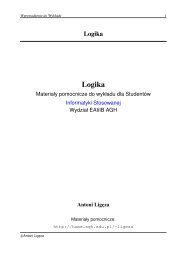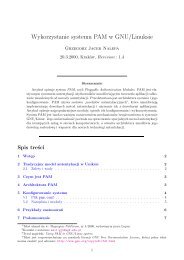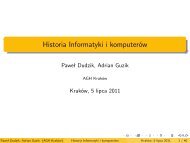An Evaluation of Knowledge Base Systems for Large OWL Datasets
An Evaluation of Knowledge Base Systems for Large OWL Datasets
An Evaluation of Knowledge Base Systems for Large OWL Datasets
You also want an ePaper? Increase the reach of your titles
YUMPU automatically turns print PDFs into web optimized ePapers that Google loves.
(type Faculty ?Y)<br />
(type Course ?Z)<br />
(advisor ?X ?Y)<br />
(takesCourse ?X ?Z)<br />
(teacherOf ?Y ?Z)<br />
Besides the a<strong>for</strong>ementioned features <strong>of</strong> class Student and the wide hierarchy <strong>of</strong> class<br />
Faculty, like Query 2, this query is characterized by the most classes and properties in<br />
the query set and there is a triangular pattern <strong>of</strong> relationships.<br />
Query10<br />
(type Student ?X)<br />
(takesCourse ?X http://www.Department0.University0.edu/GraduateCourse0)<br />
This query differs from Query 6, 7, 8 and 9 in that it only requires the (implicit) sub-<br />
ClassOf relationship between GraduateStudent and Student, i.e., subClassOf relationship<br />
between UndergraduateStudent and Student does not add to the results.<br />
Query11<br />
(type ResearchGroup ?X)<br />
(subOrganizationOf ?X http://www.University0.edu)<br />
Query 11, 12 and 13 are intended to verify the presence <strong>of</strong> certain <strong>OWL</strong> reasoning capabilities<br />
in the system. In this query, property subOrganizationOf is defined as transitive.<br />
Since in the benchmark data, instances <strong>of</strong> ResearchGroup are stated as a suborganization<br />
<strong>of</strong> a Department individual and the later suborganization <strong>of</strong> a University<br />
individual, inference about the subOrgnizationOf relationship between instances <strong>of</strong><br />
ResearchGroup and University is required to answer this query. Additionally, its input<br />
is small.<br />
Query12<br />
(type Chair ?X) (type Department ?Y)<br />
(worksFor ?X ?Y)<br />
(subOrganizationOf ?Y http://www.University0.edu)<br />
The benchmark data do not produce any instances <strong>of</strong> class Chair. Instead, each Department<br />
individual is linked to the chair pr<strong>of</strong>essor <strong>of</strong> that department by property<br />
headOf. Hence this query requires realization, i.e., inference that that pr<strong>of</strong>essor is an<br />
instance <strong>of</strong> class Chair because he or she is the head <strong>of</strong> a department. Input <strong>of</strong> this<br />
query is small as well.<br />
Query13<br />
(type Person ?X)<br />
(hasAlumnus http://www.University0.edu ?X)<br />
Property hasAlumnus is defined in the benchmark ontology as the inverse <strong>of</strong> property<br />
degreeFrom, which has three subproperties: undergraduateDegreeFrom, mastersDegreeFrom,<br />
and doctoralDegreeFrom. The benchmark data state a person as an alumnus<br />
<strong>of</strong> a university using one <strong>of</strong> these three subproperties instead <strong>of</strong> hasAlumnus. There<strong>for</strong>e,<br />
this query assumes subPropertyOf relationships between degreeFrom and its<br />
subproperties, and also requires inference about inverseOf.




